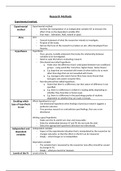Research Methods
Experimental method:
Experimental Experimental method:
method - Involves the manipulation of an independent variable (IV) to measure the
effect it has on the dependent variable (DV)
- Four ways – laboratory, field, natural or quasi.
Aims Aim:
- General statement of what the researcher intends to investigate.
- Purpose of the study.
- Narrow the focus of the research to produce an aim, often developed from
theories.
Hypotheses Hypothesis:
- Clear, precise, testable statement that states the relationship between
variables to be investigated.
- Need to state this before conducting research.
- Directional/one-tailed hypothesis:
o Make clear the difference that is anticipated between two conditions/
groups – using words like ‘more/less, higher/lower, faster/slower’
o E.g. dogs that are rewarded with treats sit when told to do so more
often than dogs that are not rewarded with treats.
o E.g. teenagers who watch horror films have more friends than
teenagers who watch romantic films.
- Non-directional/two-tailed hypothesis:
o States that there is a difference, but that nature of difference is not
specified.
o E.g. there is a difference in children’s reading ability depending on
whether they have blue or brown eyes.
o E.g. there is a difference in the psychology grades of students
dependent on whether they are male or female.
Deciding which Which hypothesis to use?
type of hypothesis - Use directional hypothesis when findings of previous research suggests a
to use particular outcome.
- If no previous research or contradictory past findings, then use a non-
directional.
Writing a good hypothesis:
- Make sure the IV and DV are clear and measurable.
- State the relationship between IV and DV (do not state the aim).
- Select the appropriate hypothesis (direction/non-directional).
Independent and Independent variable:
dependent - Aspect of the experimental situation that is manipulated by the researcher (or
variables changes naturally), so that the effect on the DV can be measured.
- Simply – what changes or is manipulation.
Dependent variable:
- The variable that is measured by the researcher (any effect should be caused
by change in IV).
- Simply – what you record or measure.
Levels of the IV Levels of the IV:
, -To test the effect of the IV on the DV, different experimental conditions are
needed
- Need to be at least two levels:
o A control condition – no manipulation or change.
o An experimental condition – manipulation or change occurs.
Operationalisatio Operationalisation:
n of variables - Clearly defining variables in terms of how they can be measured.
- Makes hard to define concepts easier by breaking them down into constituent
parts which makes it easier to ensure the variables are not fuzzy or
unmeasurable.
Example Aim:
- Investigate whether high confidence levels in children affect their level of
obedience.
IV:
- Score on a confidence scale.
DV:
- Number of instructions from a teacher obeyed.
Directional:
- Children who score over 50 on the confidence scale obey more instructions
from the teacher than children who score under 50.
Non-directional:
- There is a difference in the number of teacher instructions obeyed between
the children who score over 50 on the confidence scale and children that score
under 50.
- OR children who score over 50 on the confidence scale differ from those who
score below 50 in terms of how much they obeyed their teacher.
EXAM QUESTIONS 2 marks:
Suggest two occasions when a psychologist might choose to use a non-directional
hypothesis.
3 marks:
Explain the difference between an aim and a hypothesis.
Identify one way in which each of the following terms could be operationalised.
Application question:
Research suggests judgements of guilt vary depending on the severity of the
consequences. In other words, how guilty someone is judged to be is based on the
amount of damage done (the more damage, the more guilty).
To test this, a researcher wrote two paragraphs. The two paragraphs were the same
apart from the last sentence. Both paragraphs described a man who parked his car on
a hill and went to buy cigarettes at a nearby shop. Whilst the man was in the shop the
car began to roll down the hill.
In Paragraph A, the car came to a stop at the bottom of the hill, slightly scratching
another parked car.
, In Paragraph B, the car hit a mother and her daughter, injuring both.
Ten participants read Paragraph A and ten different participants read Paragraph B. All
20 participants then had to rate on a 10-point scale how guilty they thought the driver
of the car was. A rating of 1 on the scale meant not at all guilty, a rating of 10 meant
completely guilty.
1. What is the aim of the investigation above? (1 mark)
2. Define the term independent variable. (1 mark)
3. Identify the independent variable in the investigation above. (1 mark)
4. Define the term dependent variable. (1 mark)
5. Define the term operationalisation. (1 mark)
6. Explain how the researcher operationalised the dependent variable in the
investigation above. (2 marks)
7. Should the researcher use a directional or non-directional hypothesis for the
investigation above? Justify your answer. (2 marks)
8. Based on your answer to 7, write a suitable hypothesis for the investigation
above. (2 marks)
9. Explain the difference between an aim and a hypothesis. (2 marks)
Control of variables:
Extraneous Extraneous variables:
variables - A variable, other than the IV, that may have an effect on the DV if not
controlled.
- These do NOT vary systematically with the IV.
- Need to be identified and controlled prior to the study.
- Can be subdivided into:
o Participant variables – individual differences between participants –
age, personality, motivation, intelligence, concentration and gender.
o Situational variables – features of the experimental situation – noise,
weather, instructions, temperature and time of day.
- Example: If you were testing how the investigator effect would influence
performance on a math test (told it was suitable for younger students or
degree students – hard or easy), an extraneous variable would be existing
maths ability of students (would need to use a matched-pairs design to
control).
Confounding Confounding variables:
variables - A variable, other than the IV, that may have affected the DV, so we cannot be
sure that the IV is the source of change in DV
- Vary systematically with the IV.
- E.g. if studying talkativeness from energy drink consumption then personality
is a confound as extraverted participants will talk more anyway.
- An extraneous variable which correlates with both the IV and DV.
Demand Demand characteristics:
characteristics - Cue from the researcher or research situation that may be interpreted by
participants as revealing the purpose of the study.
- This leads to a change in behaviour where participants act according to how
, they think they should (e.g. under- or overperform).
- Participants are not passive in experiments; they try to guess the aims of the
experiment and this participant reactivity causes unnatural behaviour.
Investigator Investigator effects:
effects - The effect of the investigator’s behaviour on the research outcome.
- The investigator can do this consciously (to achieve the aims they want) or
unconsciously.
- Can occur at any stage of the research – design, sample selection (picking
participants that are right for the experiment) and through interaction with
participants (e.g. smile more, more reactive, leading questions).
Randomisation Randomisation:
- The use of chance in order to control for effects of bias when using materials
and deciding order of conditions.
- One way for minimising the effects of extraneous and confounding variables.
- Order of conditions should be randomly determined and if participants take
part in all conditions, they should counterbalance the order, so they do not all
complete the conditions in the same order (in case order changes the results).
Standardisation Standardisation:
- Using the exact same formulised procedures and instructions for all
participants in a research study.
- Ensures all participants are subject to the same environment.
- Means that non-standard changes do not act as an extraneous variable.
EXAM QUESTIONS 2 marks:
Outline what is meant by the term demand characteristics.
Suggest one example of how randomisation may be used within psychological
research.
3 marks:
Explain the difference between an extraneous variable and confounding variable.
4 marks:
Outline what is meant by investigator effects and explain why it is important to
control these within an investigation.
Application question:
A researcher wanted to investigate the effect of presentation of material on recall. He
used 40 participants in the investigation. In Condition 1, 20 participants were given a
list of 30 words in colour and given two minutes to learn them. In Condition 2, 20
different participants were given the same 30 words in black type and two minutes to
learn them.
All 40 participants were then given three minutes to recall as many of the words as
they could.
1. Explain what is meant by the term extraneous variable. (2 marks)
2. Identify three extraneous variables that should have been controlled in the
investigation above. (3 marks)
3. Explain how the researcher might have controlled the three extraneous
variables you have identified in your answer to 2. (3 marks)
4. Explain what is meant by the term confounding variable. (2 marks)
5. Identify and explain one confounding variable that may have occurred in the
investigation above. (2 marks)
6. Explain what is meant by demand characteristics. (2 marks)





